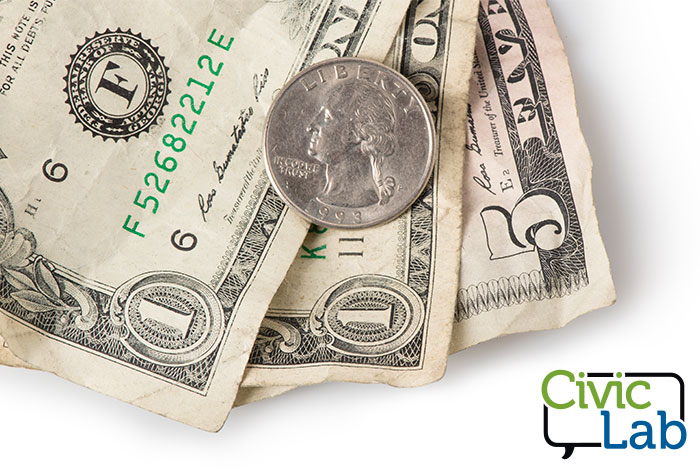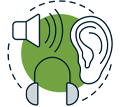Civic Lab Online: The Raise the Wage Act
Posted on May 3, 2021 at 6:00 am

About Civic Lab Online
Civic Lab Online provides information on issues facing our community for you to explore. Take a look at thought-provoking materials for teens and adults that allow us to engage in open conversation and grow together as a community. You’ll find all past topics on the Civic Lab Online web page.
The Raise the Wage Act
Increasing the minimum wage has been a topic of discussion in the news due, in part, to President Biden’s support in recent legislation. What would change if we changed minimum wage? What are the pros and cons of raising the minimum wage?

Fast Facts
What are the rules regarding minimum wage right now?
Minimum wage is the lowest amount that employers can pay most workers. There are laws setting the minimum wage for the whole country, within states, and sometimes within municipalities of states. For example, the federal minimum wage in the U.S. is $7.25 per hour. The minimum wage in the state of Washington is $13.69 per hour. Both SeaTac ($16.57) and Seattle ($16.69) have declared additional minimum wage ordinances, so their minimum wages are higher than other areas in Washington.
Not everyone has to be paid the federal minimum wage. Exceptions include workers who make tips and can be paid as little as $2.13 per hours as long as the tips they make always make up the difference between their salary and the minimum wage. Other exceptions include workers under the age of 20 who may be paid $4.25 per hour for no more than 90 days of work. Occupations commonly exempt from the minimum wage provision of the Fair Labor Standards Act (FLSA) include farmworkers, seasonal amusement park workers, and salaried employees whose incomes meet a certain threshold. Employers hiring students can get a certificate from The Department of Labor and Industries (L&I) allowing them to pay students 85% of minimum wage, and student learners in vocational training can be paid 75% of the minimum wage. A certificate can also be obtained to pay those with disabilities affecting their productivity (blindness, mental illness, developmental disabilities, cerebral palsy, alcoholism, or drug addiction) a subminimum wage according to how much work they can do.
The Wage and Hour Department offices of L&I are responsible for enforcing minimum wage laws (such as the Fair Labor Standards Act) and explaining how they are applied with materials such as the Handy Reference Guide to the Fair Labor Standards Act.
District of Columbia has the highest state/territory minimum wage at $15 per hour. Nineteen states do not have a minimum wage higher than the required federal minimum wage of $7.25: Alabama, Idaho, Indiana, Iowa, Kansas, Kentucky, Louisiana, Mississippi, Georgia, North Dakota, North Carolina, New Hampshire, Oklahoma, Pennsylvania, Texas, Utah, Virginia, Wisconsin, and Wyoming.
The federal minimum wage does not increase automatically. Congress must pass a bill which the President signs into law in order for the minimum wage to go up (last raised in 2009).
What are the pros and cons of a minimum wage increase?
Those who support an increase argue that workers must earn a living wage, which is a wage high enough to cover basic living expenses when working full time. Proponents of raising the minimum wage also believe it will increase consumer spending to boost the economy and increase worker productivity and company loyalty. A major challenge of passing legislation to support these ideas is justifying a specific wage that will be appropriate in every area of the country.
Those who oppose a minimum wage increase believe employers will hire fewer unskilled workers, disabled workers, and teenagers because hiring workers in these categories do not justify the increased cost. They also point to a possibility that employers may either expect more work from their remaining employees or pass along increased costs to the consumer to make up for what they must pay workers.
What legislation might increase minimum wage?
Senator Robert C. Scott sponsored The Raise the Wage Act, which was passed by the House of Representatives in 2019. If approved by the Senate and passed into law, the bill would remove the special provisions for those making tips, those under the age of 20, and people with disabilities. Minimum wage would be the same for everyone. The Labor Department would assist businesses in adjusting to the new rules. Minimum wage would increase gradually over a period of 7 years. The bill has been introduced several times: in 2015, proposing to raise the federal minimum wage to $12.00 per hour by 2020, and again in 2017 and 2019, proposing to gradually increase the minimum wage to $15.00 per hour.
The Fight for $15 campaign is a movement that began when fast food workers in New York City organized a walkout strike in November 2012 to demand higher wages. Terrence Wise, a fast-food worker and prominent member of the campaign, testified before Congress in February 2019 to support The Raise the Wage Act.
The state minimum wages in 18 states went up in January 2019. As of 2019, 17 states and the District of Columbia had tied or were scheduled to tie their minimum wages to the consumer price index (CPI) or the personal consumption expenditures price index (PCEPI), both of which measure changes in the prices of goods and services, thus allowing wage increases to reflect increases to the cost of living.
The House passed a version of the American Rescue Plan, including an increase in the minimum wage to $15 an hour, but senators voted to support the Senate parliamentarian’s ruling requiring its removal.
Read, Watch, Listen

READ
Cooper, David, et al. “Raising the Federal Minimum Wage to $15 by 2025 Would Lift the Pay of 32 Million Workers: A Demographic Breakdown of Affected Workers and the Impact on Poverty, Wages, and Inequality.” Economic Policy Institute, 9 Mar. 2020, www.epi.org/publication/raising-the-federal-minimum-wage-to-15-by-2025-would-lift-the-pay-of-32-million-workers.
This comprehensive analysis compiled in support of a minimum wage increase demonstrates the demographic breakdown of affected workers and the impact on poverty, wages, and inequality across America, particularly for people of color.
Hayes, Adam. “Does Raising the Minimum Wage Increase Inflation?” Investopedia, 7 July 2020, www.investopedia.com/ask/answers/052815/does-raising-minimum-wage-increase-inflation.asp.
A brief look at the differing views on whether raising minimum wage has a positive or negative impact on the U.S. economy and why it might differ depending on the circumstances.
“What Harm do Minimum Wages do?” The Economist, vol. 436, no. 9207, Aug 15, 2020, pp. 61-62. ProQuest, https://www.scld.org/digital_downloads/proquest/.
A summary of the research conducted over the decades about when minimum wage increases work to good effect and when they do harm. Economists use charts, graphs, and studies to show what we’ve discovered over time.

WATCH
ABC News. “A Brief History of the U.S. Minimum Wage | ABC News.” YouTube, uploaded by ABC News, 9 May 2016, www.youtube.com/watch?v=EhreonsZU4c&feature=youtu.be.
From textile workers’ strikes to partisan debates in Congress, this offers a brief history of the minimum wage in the United States.
TIME Magazine. “A History Of The Minimum Wage | TIME.” YouTube, uploaded by TIME, 3 Mar. 2014, www.youtube.com/watch?v=tQE0ldkiKo0&feature=youtu.be.
A timeline sharing popular music of the time and comparing minimum wage throughout the decades to the equivalent spending power in 2014 (the year this video was released). When did minimum wage have the most spending power?

LISTEN
Casselman, Ben, and Sheera Frenkel. “The Fight for (and Against) a $15 Minimum Wage.” The Daily (The New York Times Podcast), The New York Times, 17 Mar. 2021, www.nytimes.com/2021/03/17/podcasts/the-daily/minimum-wage-stimulus-package.html. Economics reporter Ben Casselman talks about attitudes toward minimum wage throughout the decades and what might happen if legislation increases the federal minimum to $15 per hour.
Digital Resources

Gale in Context: Opposing Viewpoints
Access this resource to learn more about the minimum wage.
Print & Other Materials in Our Catalog
Search our catalog for books, large print, eBooks, and audiobooks about the minimum wage.
Downloadable Documents
Fast Facts: The Raise the Wage Act
Read, Watch, Listen: The Raise the Wage Act
SOURCES
Congressional Research Service (CRS) of the Library of Congress. “H.R.582 – 116th Congress (2019–2020): Raise the Wage Act.” Congress.Gov | Library of Congress, Library of Congress, www.congress.gov/bill/116th-congress/house-bill/582. Accessed 23 Apr. 2021.
“CPI Home: U.S. Bureau of Labor Statistics.” U.S. Bureau of Labor Statistics, www.bls.gov/cpi. Accessed 23 Apr. 2021.
Economic Policy Institute. “Minimum Wage Tracker.” Economic Policy Institute, 7 Jan. 2021, www.epi.org/minimum-wage-tracker/#/min_wage/Washington.
“Fact Sheet #39: The Employment of Workers with Disabilities at Subminimum Wages | U.S. Department of Labor.” U.S. Department of Labor, U.S. Department of Labor, www.dol.gov/agencies/whd/fact-sheets/39-14c-subminimum-wage. Accessed 23 Apr. 2021.
“Handy Reference Guide to the Fair Labor Standards Act | U.S. Department of Labor.” U.S. Department of Labor, U.S. Department of Labor, www.dol.gov/agencies/whd/compliance-assistance/handy-reference-guide-flsa. Accessed 23 Apr. 2021.
“History of Federal Minimum Wage Rates Under the Fair Labor Standards Act, 1938 – 2009 | U.S. Department of Labor.” U.S. Department of Labor, U.S. Department of Labor, www.dol.gov/agencies/whd/minimum-wage/history/chart. Accessed 23 Apr. 2021.
“Local Offices | U.S. Department of Labor.” U.S. Department of Labor, U.S. Department of Labor, www.dol.gov/agencies/whd/contact/local-offices. Accessed 23 Apr. 2021.
“Minimum Wage | U.S. Department of Labor.” Wage and Hour Division | U.S. Department of Labor, U.S. Department of Labor, www.dol.gov/agencies/whd/minimum-wage. Accessed 23 Apr. 2021.
“Minimum Wage.” Washington State Department of Labor & Industries, Washington State Department of Labor & Industries, https://lni.wa.gov/workers-rights/wages/minimum-wage. Accessed 23 Apr. 2021.
“Minimum Wage.” Gale Opposing Viewpoints Online Collection, Gale, 2019. Gale in Context: Opposing Viewpoints, https://link.gale.com/apps/doc/PC3010999333/OVIC?u=spok67112&sid=OVIC&xid=ab168440. Accessed 23 Apr. 2021.
Paycor. “Minimum Wage by State and 2021 Increases.” Paycor, 4 Jan. 2021, www.paycor.com/resource-center/articles/minimum-wage-by-state.
“Personal Consumption Expenditures Price Index | U.S. Bureau of Economic Analysis (BEA).” U.S. Bureau of Economic Analysis (BEA), www.bea.gov/data/personal-consumption-expenditures-price-index. Accessed 23 Apr. 2021.
“State Minimum Wage Laws | U.S. Department of Labor.” U.S. Department of Labor, U.S. Department of Labor, www.dol.gov/agencies/whd/minimum-wage/state. Accessed 23 Apr. 2021.
The White House. “President Biden Announces American Rescue Plan.” The White House, 20 Jan. 2021, www.whitehouse.gov/briefing-room/legislation/2021/01/20/president-biden-announces-american-rescue-plan.
Tags: adults, civic lab, community, cost, economics, federal, goods, inflation, labor, law, living wage, minimum wage, teens, wages, work, workers
